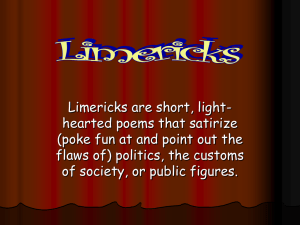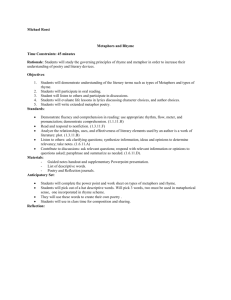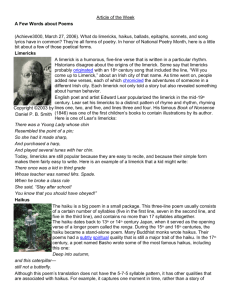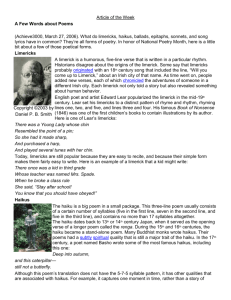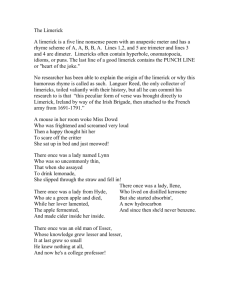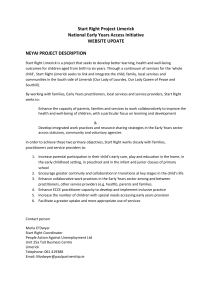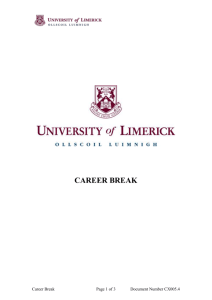Langdellian Limericks - Southwestern Law School
advertisement
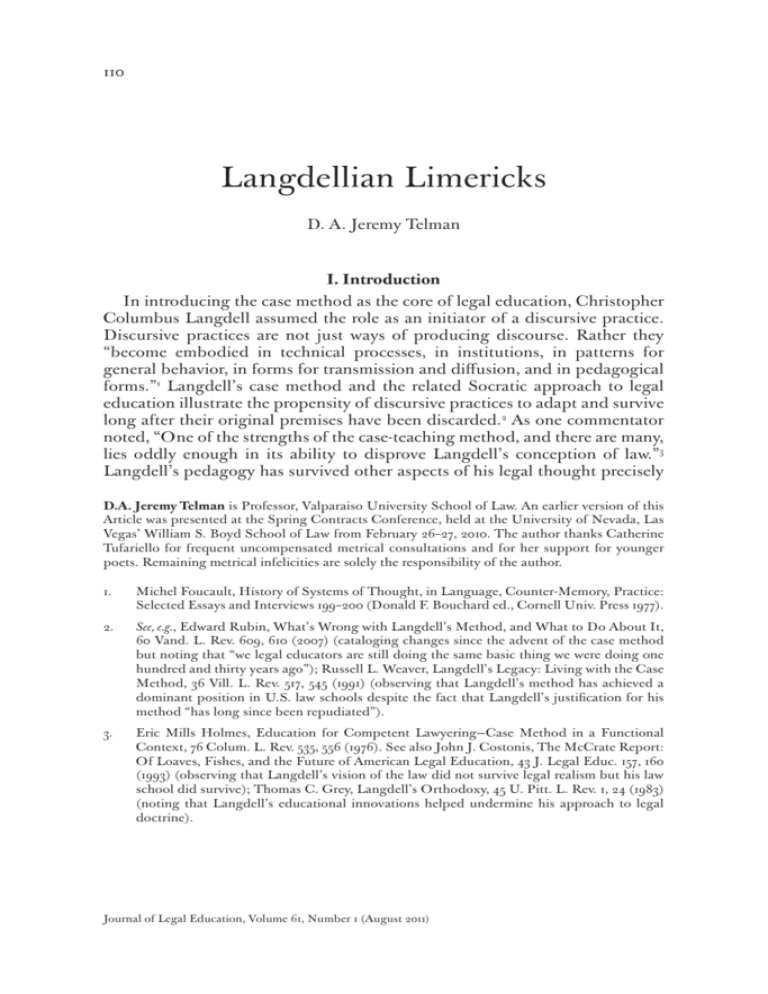
110 Langdellian Limericks D. A. Jeremy Telman I. Introduction In introducing the case method as the core of legal education, Christopher Columbus Langdell assumed the role as an initiator of a discursive practice. Discursive practices are not just ways of producing discourse. Rather they “become embodied in technical processes, in institutions, in patterns for general behavior, in forms for transmission and diffusion, and in pedagogical forms.”1 Langdell’s case method and the related Socratic approach to legal education illustrate the propensity of discursive practices to adapt and survive long after their original premises have been discarded.2 As one commentator noted, “One of the strengths of the case-teaching method, and there are many, lies oddly enough in its ability to disprove Langdell’s conception of law.”3 Langdell’s pedagogy has survived other aspects of his legal thought precisely D.A. Jeremy Telman is Professor, Valparaiso University School of Law. An earlier version of this Article was presented at the Spring Contracts Conference, held at the University of Nevada, Las Vegas’ William S. Boyd School of Law from February 26–27, 2010. The author thanks Catherine Tufariello for frequent uncompensated metrical consultations and for her support for younger poets. Remaining metrical infelicities are solely the responsibility of the author. 1. Michel Foucault, History of Systems of Thought, in Language, Counter-Memory, Practice: Selected Essays and Interviews 199–200 (Donald F. Bouchard ed., Cornell Univ. Press 1977). 2. See, e.g., Edward Rubin, What’s Wrong with Langdell’s Method, and What to Do About It, 60 Vand. L. Rev. 609, 610 (2007) (cataloging changes since the advent of the case method but noting that “we legal educators are still doing the same basic thing we were doing one hundred and thirty years ago”); Russell L. Weaver, Langdell’s Legacy: Living with the Case Method, 36 Vill. L. Rev. 517, 545 (1991) (observing that Langdell’s method has achieved a dominant position in U.S. law schools despite the fact that Langdell’s justification for his method “has long since been repudiated”). 3. Eric Mills Holmes, Education for Competent Lawyering—Case Method in a Functional Context, 76 Colum. L. Rev. 535, 556 (1976). See also John J. Costonis, The McCrate Report: Of Loaves, Fishes, and the Future of American Legal Education, 43 J. Legal Educ. 157, 160 (1993) (observing that Langdell’s vision of the law did not survive legal realism but his law school did survive); Thomas C. Grey, Langdell’s Orthodoxy, 45 U. Pitt. L. Rev. 1, 24 (1983) (noting that Langdell’s educational innovations helped undermine his approach to legal doctrine). Journal of Legal Education, Volume 61, Number 1 (August 2011) Langdellian Limericks 111 because the former is an institutionalized discursive practice.4 Law professors teach using Langdell’s method in part because that is how they learned the law, and in part because the teaching materials most readily available to them facilitate teaching through the case method. But inertia alone does not explain Langdell’s resilience.5 Many professors utilize Langdell’s approach because they think it is the method best-suited to legal education,6 given the physical, financial and practical constraints within which law schools must operate.7 The case method and the Socratic style of teaching persist and are still practiced by the vast majority of legal academics, at least in the larger doctrinal courses.8 There is no reason to think that law schools will abandon Langdell’s pedagogical model entirely and so there is every reason to make that model as responsive as it can be to the needs of 21st century law students. In part, this goal can be achieved by supplementing Langdell’s approach with an eye to addressing the concerns raised by its critics. Those committed to a legal pedagogy best suited to the task of preparing law students for the challenges they will face after they graduate must never 4. See Todd D. Rakoff & Martha Minow, A Case for Another Case Method, 60 Vand. L. Rev. 597, 599 (2007) (likening the survival of the case method to that of religious traditions that “once embedded in custom and experience, give rise to new rationales when the old ones fade away”). 5. See John C.P. Goldberg, What Nobody Knows, 104 Mich. L. Rev. 1461, 1496 (2006) (rejecting the notion that the case method’s survival can be attributed to “some combination of inertia and faculty inattentiveness”). 6. See, e.g., Rakoff & Minow, supra note 4, at 598 (crediting Langdell’s method with meeting the multiple goals of legal education); Ruta K. Stropus, Mend It, Bend It, and Extend It: The Fate of Traditional Law School Methodology in the 21st Century, 27 Loy. U. Chi. L.J. 449, 450 (1996) (describing Langdell’s method as the “best means for teaching students to analyze effectively, think independently and express themselves verbally”). However, Rakoff and Minow conclude that Langdell’s method is no longer adequate if the aim is to teach 21st century students to think like laywers. Rakoff & Minow, supra note 4, at 600. 7. See Robert Stevens, Law School: Legal Education in America from the 1850s to the 1980s 63 (Univ. North Carolina 1983) (noting that the case method permitted law school class sizes to expand to the size of the largest-available lecture halls); Costonis, supra note 3, at 160–61 (contending that the case method is a more significant economic than pedagogical phenomenon, since it facilitates large-class teaching). 8. See, e.g., Elizabeth Mertz, The Language of Law School: Learning To “Think Like a Lawyer” 141–73 (Oxford Univ. Press 2007) (discussing literature contending that use of the Socratic Method is on the wane and concluding that most law professors in the first year still rely on some version of a dialogic method, although classic, strict Socratic teaching is now a rarity); Roy Stuckey and Others, Best Practices for Legal Education: A Vision and a Roadmap 207 (CLEA 2007) (“The principal method for teaching legal doctrine and analytical skills in United States’ law schools is the Socratic dialogue and case method.”); Steven I. Friedland, How We Teach: A Survey of Teaching Techniques in American Law Schools, 20 Seattle U. L. Rev. 1, 28 (1996) (reporting survey results indicating that 97 percent of law professors teaching first-year courses employ the case method); Rakoff & Minow, supra note 4, at 597 (observing that the first-year curriculum “remains remarkably similar” to that invented by Langdell); Weaver, supra note 2, at 543 (calling the case method “unquestionably the primary mode of instruction in U.S. law schools” and noting that it had been adopted by every U.S. law school). 112 Journal of Legal Education blind themselves to the limitations of their chosen pedagogy. Still, too often in the feeding frenzy of self-criticism, legal scholars have been remiss in failing to recognize the advantages of Langdell’s approach over the traditional lecture. Having taught history on the undergraduate level, I am most appreciative of the Socratic requirement that students come to class prepared and engaged. Too many students sail through their undergraduate educations without ever being really challenged to engage with difficult material in a creative and yet disciplined manner. The Socratic experience may not always be pleasant for students who are shy or otherwise reluctant to speak in class, but on the whole, the case method promotes a brand of active learning that is often sadly lacking on the undergraduate level.9 Indeed, one of the greatest challenges I have experienced in legal education is to get the students to transcend the rote repetition of information imparted during class time and to engage in the constructive play with legal concepts and strategies that is the stuff of real advocacy and also the stuff of legal limerick composition. The case method survives in part because it is a flexible approach to law teaching. One can always combine Socratic teaching with lectures on doctrine, problems, group work, drafting exercises, and other useful approaches. In employing the case method, one can play with Langdell’s method in various ways, one of which is the subject of this Article. In my first years of teaching, I composed limericks to memorialize key cases and shared those limericks with my students during class.10 I add to the collection of limericks when I teach new materials or when they seem to require some tweaking. In what follows, I justify this practice as a means of accomplishing some of the goals of the case method and as a means of addressing some of the criticisms of that method. II. The Pedagogy of Langdellian Limericks11 This section illustrates how one can supplement the case method with legal limericks in a way that tempers the naive scientism, formalism, intimidation of students and other-worldliness that can characterize Socratic courses. Limericks are not a panacea. There are innumerable other ways in which Langdell’s method can be—and has been—improved upon. This section 9. See generally Michael L. Richmond, Teaching Law to Passive Learners: The Contemporary Dilemma of Legal Education, 26 Cumb. L. Rev. 943 (1996). 10. This article contains only a sampling of the limericks. The complete collection of my Langdellian Limericks can be found in the appendix. Those interested in seeing more limericks can find both Contracts and Business Associations Limericks on the ContractsProf Blog (the official blog of the AALS Section on Contracts), available at http://lawprofessors. typepad.com/contractsprof_ blog/limericks/. 11. A colleague objected that my poems are not really limericks because limericks are supposed to be bawdy and mine generally are not. Research suggests that limericks, while often colorful, need not be lubricious. For example, the celebrated nonsense poet Edward Lear is among the most prolific of limericists, and his limericks are quite tame. See Edward Lear, The Complete Verse and Other Nonsense 328–82 (Vivien Noakes ed., Penguin 2002). Some students have objected to my limericks on the ground that limericks are supposed to be funny, or at least clever, and mine, they tell me, are neither. But see id. Langdellian Limericks 113 consists of a presentation of legal limericks, most of which summarize a case, with an explanation of how each limerick can be used to achieve a pedagogical goal in connection with the case method. The limericks are first and foremost little jokes and pokes that reduce the anxiety that the Socratic Method can induce. Often, the joke is on the professor. This is intentional. Langdell’s critics point out that the case method and Socratic questioning do not really promote active learning because the Socratic Method “humiliates, intimidates and silences students.”12 The limericks can counteract those aspects of Socratic teaching because they have a leveling effect that suspends the hierarchical and adversarial nature of the Socratic Method. The suspension is temporary, but its effects spill over and contribute to a more collaborative learning environment. The limericks level because limericks are silly and also because they don’t all work. Sometimes there are obvious metrical stumbles, comic inversions or absurdly forced rhymes. More often, they present only the most simpleminded renditions of the facts and law of the case. When students laugh at the limerick, they are, in effect, laughing at the professor, and perhaps to some extent at the case method, the legal profession, and their careerist selves, but the laughter is not malicious. According to some critics, Langdell’s approach assumes a pre-existing body of law that students passively learn rather than learning to think of the law as something that they will have a hand in shaping.13 Limericks are a lighthearted effort to summarize cases at a level that any student can attempt for herself. The fact that they do so imperfectly or incompletely gives students a sense of how cases can be manipulated for different purposes and often do not stand for one clear principle that is easily applied in certain circumstances. For example, many contracts professors use Ricketts v. Scothorn14 to introduce the doctrine of promissory estoppel. The Ricketts court enforced a grandfather’s gratuitous promise made to his granddaughter Katie in 1891, to set aside $2,000 for her and to pay a 6 percent annuity on the principal.15 In reliance on this promise, Katie quit her job. The case teaches well, but the award of full expectation damages is troubling, given that Katie resumed work after her grandfather stopped paying the annuity.16 If the purpose of damages in such a 12. James R. Beattie, Jr., Socratic Ignorance: Once More Into the Cave, 105 W. Va. L. Rev. 471, 472 (2003); see also Stropus, supra note 6, at 456 (citing critics who claim that the Socratic Method causes psychological scarring). 13. Rubin, supra note 2, at 649; see also Karl Llewellyn, The Current Crisis in Legal Education, 1 J. Legal Educ. 211, 211–12 (1948) (faulting the case method for providing solutions to the problems posed in advance and thus not encouraging students to develop their own powers of reasoning and problem-solving). 14. 77 N.W. 365 (Neb. 1898). 15. Id. at 367. 16. See id. at 366 (finding that plaintiff was out of work for about a year and then found a position with the consent and assistance of her grandfather). 114 Journal of Legal Education case is to permit Katie to recover her reliance interest, the award of expectation damages in this case is extravagant.17 The limerick reflects the difficulty of fitting the doctrine of estoppel into contracts law: This was the start of estoppel: Said Grandpa to Katie, “Pop-Pop’ll Set you up nice.” She took his advice, And left her old job in the shop-pel. Such imperfections may reflect poorly on the poet, but they are intended to indicate that often in law we cannot get the cases to do exactly what we want them to do. They do not always stand for clear rules or thoughtful legal reasoning. Often the best response to a case really is bemusement or befuddlement. Students should not always be too concerned if they cannot make sense of a case, nor should they always treat cases as authoritative statements of the law to be passively absorbed and obeyed. Limericks thus help cultivate a healthy skepticism regarding the law. Another example of a perhaps usefully unsuccessful limerick is this attempt at an explication of Judge Cardozo’s opinion in Allegheny College v. National Chautauqua County Bank.18 In his virtuoso opinion, Judge Cardozo found a way to hold a woman to her charitable pledge despite the fact that, as Leon Lipson described it, he could not really base his decision on the solidly established doctrine of consideration because the facts did not really support such a conclusion. Nor could he base his decision on the doctrine of promissory estoppel, which the facts might have supported, because the doctrine was not yet firmly established.19 Lipson likened Cardozo’s opinion to a thaumatrope, in which two images are depicted on different sides of a card—for example, a bird on one side and a cage on the other. When the card is twirled, we see an image of a bird in a cage.20 Cardozo’s opinion thus arrives at a fair resolution through a sort of sleight of hand. This limerick imitates that trick by merging two words into one forced rhyme: Although her estate was inheritable, Ms. Johnston chose to be charitable. A bargain was struck; Her heir’s out of luck: To the College, Cardozo was fairitable. 17. Lon L. Fuller & William R. Perdue, Jr., The Reliance Interest in Contract Damages: 1, 46 Yale L.J. 52, 53 (1936). 18. 159 N.E. 173 (N.Y. 1927). 19. Leon Lipson, The Allegheny College case, 29 Yale L. Rep. 8, 11 (1977). 20. Id. But see Curtis Bridgeman, Allegheny College Revisited: Cardozo, Consideration, and Formalism in Context, 39 U.C. Davis L. Rev. 149, 161–62 (2005) (arguing that the parties did not really brief the issue of promissory estoppel and that the doctrine played little role in the opinion). Langdellian Limericks 115 Perhaps Cardozo attempted to do what he considered fair and equitable to the college in the case; perhaps he was just being charitable. Paint both options on a thaumatrope and spin it: students might see “fairitable.” A. Limericks as Aides-Memoires One advantage of the case method is that the cases often involve colorful facts, which can serve as a sort of memory hook on which to hang an article of legal doctrine. However, students learn in different ways,21 which is, by the way, also a reason to use PowerPoint in the classroom. Reading a case, and even listening as others engage in Socratic dialogue with the professor, may not be sufficient to lodge the facts of the case along with the attendant rule in each student’s mind. The limericks attempt to reinforce the legal rules by presenting the facts and the rules of the cases in a format that will be more likely to survive the other batteries to which the 1L mind is subject. Students who have an ear for meter and rhyme—or who develop such an ear through exposure to scores of legal limericks—may find that the limericks aid them in remembering which cases are associated with which rules. Ray v. William G. Eurice Brothers22 illustrates both the objective theory of contracts with respect to intent to be bound and the nature of contracts damages. The Eurice brothers signed an agreement to build a house for Ray.23 But when the brothers took a closer look at Ray’s specifications, they realized that their company could not possibly build the house to Ray’s specifications for the contract price.24 They refused to perform, and the trial court was inclined to take pity on these humble builders, whom the trial judge described as “hatchet and saw men,”25 but the appellate court would not permit them to escape the contract.26 Ray’s specs were enough to confound These “hatchet and saw” men, whose ground For breaching the pact Was mistake of fact, But they signed it and so they are bound. 21. See, e.g., Paul L. Caron & Rafael Gely, Taking Back the Law School Classroom: Using Technology To Foster Active Student Learning, 54 J. Legal Educ. 551, 565 (2004) (proposing an approach to legal education that students “come into the classroom with multiple forms of intelligence acquired in different ways”); Benjamin V. Madison, III, The Elephant in Law School Classrooms: Overuse of the Socratic Method as an Obstacle to Teaching Modern Law Students, 85 U. Det. Mercy L. Rev. 293, 312–15 (2008) (noting the increasing recognition on the part of law school professors of the need to accommodate students’ differing learning styles). 22. 93 A.2d 272 (Md. 1952). 23. Id. at 275. 24. Id. at 275-76. 25. Id. at 276. 26. Id. at 279. 116 Journal of Legal Education The limerick reinforces the simple rule of the case: absent fraud, duress, incapacity or mistake, a party is bound by what she signs.27 Few cases are more limerick-worthy than Mills v. Wyman,28 in which Seth Wyman stiffs Daniel Mills, a Good Samaritan who nursed Seth’s son Levi in what the court believed to be Levi’s last hours.29 Seth Wyman’s interior forum Is not the law’s sanctum sanctorum With this none would quarrel: Seth’s conduct’s immoral. Still, he breaches not law but decorum. The Mills v. Wyman limerick summarizes the rule of the case, but it also invites discussion and reflection on the relationship of law and morality, a theme to which it is important to return throughout the course.30 Lenawee County Board of Health v. Messerly31 illustrates the difficulty of using the doctrine of mistake to excuse performance of a contract. The case turned on the court’s assessment of which party bore the risk of mistake.32 Messerly involved a transfer of a residential property that had an insufficient sewage disposal system, a fact discovered only after the transfer to Carl and Nancy Pickles had taken place.33 Ordinarily, one would expect the seller to be the party best positioned to discover such an imperfection in the property and thus we would expect the assumption of risk to favor the buyer. But this transfer provided for delivery of the property in an “as is” condition, and that language defeated the buyer’s excuse of mistake.34 The waste leaked in torrents, not trickles. Now the property ain’t worth two nickels. When “as is” you take, You eat your mistake, So bon appetite, Mr. Pickles. 27. Id. at 278. 28. 20 Mass. (3 Pick.) 207 (1825). 29. The court turned out to be wrong about that, as Geoffrey R. Watson has shown is his wonderful law story, In the Tribunal of Conscience: Mills v. Wyman Reconsidered, 71 Tul. L. Rev. 1749 (1997). 30. There has been a recent revival of scholarly interest in the relationship of contract law to morality. See, e.g., Seana Valentine Shiffrin, The Divergence of Contract and Promise, 120 Harv. L. Rev. 708 (2007) and three responses thereto published in Harvard Law Review’s online Forum: Barbara H. Fried, What’s Morality Got to Do with It? 120 Harv. L. Rev. F. 53 (2007), Liam Murphy, Contract and Promise, 120 Harv. L. Rev. F. 10 (2007), Charles Fried, The Convergence of Contract and Promise, 120 Harv. L. Rev. F. 1 (2007). This is a topic that strikes a chord with many students. 31. 331 N.W.2d 203 (Mitch. 1980). 32. Id. at 210–11. 33. Id. at 205. 34. Id. at 209–10. Langdellian Limericks 117 Carroll v. Beardon35 is a case about the sale of a brothel. The general rule is that illegal contracts are void,36 but this case illustrates an exception to the rule: The contract is enforceable if the party seeking enforcement is not a party to the wrongdoing.37 This limerick recites the rule while implying some skepticism as to its application in this case: In Montana arose a dispute O’er a house of doubtful repute. The seller Madame, Not in on the scam May partake of her share of the loot. The limerick, like the majority’s holding in Carroll, is in some tension with the details of the transaction, which make it clear that what the court treated as a property sale was actually the sale of an on-going business.38 The deal was structured with higher payments due during the months when the brothel was likely to have more business; thus the seller was clearly implicated in the transaction. Why did the court ignore these facts? Perhaps because the brothel was a familiar institution of some importance to the local economy.39 Its business might have been notorious but tolerated by the authorities. The case invites discussion about the interactions of local politics, institutional competence, and the law. While the limerick mimics the court’s representation that the seller was not a beneficiary of the brothel’s business, the word “loot” expresses skepticism. In Marvin v. Marvin,40 the court ruled that promises made in the context of a long-term, non-marital relationship can be enforced if they were express or can be safely implied. I offer two limericks on the subject: The Marvin court’s ruling’s propitious For relationships non-meretricious. Michelle can recover From Lee, her ex-lover, If his promises weren’t capricious. 35. 381 P.2d 295 (Mont. 1963). 36. See id. at 296 (noting that many courts will not aid either party to an illegal contract). 37. Id. at 296–97. 38. See Stewart Macaulay et al., Contracts: Law in Action, The Concise Course 386–87 (2d ed., LexisNexis 2003) (providing details from deposition testimony indicating that the sale price was far in excess of the value of the property and that payments were structured to reflect the seasonal rhythms of the prostitution business). 39. See id. at 387 (suggesting that the court might have been hesitant to shut down an illegal business that law enforcement had not shut down, though its operation was likely widely known). 40. 18 Cal. 3d 660 (1976). 118 Journal of Legal Education Michelle and Lee lived in sin, A fact once viewed with chagrin. Now she can recover From her ex-lover If he promised to keep her in gin. Sometimes you really can sum up a case in five lines, as this limerick pretty much exhausts the story of Normile v. Miller41 and serves to remind students that communication of a sale to another suffices to revoke an offer: As if sensing what lay ahead, The counterofferer said, “You snooze, you lose!” That’s enough to excuse Her for selling to Segal instead. I don’t even assign Krell v. Henry. I just recite this limerick and save my students some reading: Was Henry’s whole purpose frustrated When the King burst appendix dictated That the crown must delay Its coronation day? Yes! So contract doctrine’s updated. Recognizing the element of truth in Karl Llewellyn’s contention that it is hard to imagine a less efficient mechanism for the communication of useful information than the case method,42 one can supplement that method with some lectures on doctrine. The method can be very efficient if it is interesting. A summary of legal doctrine punctuated with limericks can be diverting enough to increase the likelihood that students will follow. B. Limericks as Illustrations of Types of Judicial Reasoning Legal Realism arose after the case method and to some extent as a reaction against the formalistic approaches associated with Langdell and his approach to pedagogy.43 First-year students often are instinctive formalists and read cases with an eye to learning a rule of law rather than attempting to analyze cases and thus to learn legal methods.44 One very important task of first-year courses is to introduce students to different approaches to the law. Law students must 41. 326 S.E.2d 11 (N.C. 1985). 42. See Llewellyn, supra note 13, at 215 (observing that he found it hard to imagine “a more wasteful method of imparting information about subject matter than the case-class”). 43. See Rubin, supra note 2, at 613 n.9 (describing the intense criticism to which legal realists subjected the case method). 44. See Cynthia G. Hawkins-León, The Socratic Method-Problem Method Dichotomy: The Debate Over Teaching Method Continues, 1998 BYU Educ. & L.J. 1, 6 (1998) (citing a 1942 report of the AALS Committee on Teaching and Examination Methods). Langdellian Limericks 119 understand that different judges will bring different jurisprudential values to the cases over which they preside and that those values can affect outcomes. Limericks can help to illustrate this aspect of the judicial process. For example, first-year contracts courses often have a narrative component. We trace, over the course of the semester, the development of the law from its more formalistic bent in the 19th century into the modern era of the Restatement (2d) and the Uniform Commercial Code. Part of the process involves familiarizing students with the differing approaches represented by Samuel Williston and Arthur Corbin. Their differences on the parol evidence rule are illustrated in Sherrodd, Inc. v. Morrison-Knudsen.45 Sherrodd, Inc. was a small business that contracted with Morrison-Knudsen to do some earthmoving work. Sherrodd agreed to do so for a fixed price, but the job turned out to be far bigger than expected.46 Morrison-Knudsen allegedly gave oral assurances that Sherrodd would be paid based on the work done, rather than the flat fee indicated in the parties’ written agreement.47 When Morrison-Knudsen then refused to pay more than the flat fee, the court sided with MorrisonKnudsen, finding that Sherrodd’s allegation of fraud was not the sort that could overcome the parol evidence rule.48 Behold, parol’s bitter fruit: Sherrodd’s claim was deemed moot! If he only knew, The great Corbin would spew To see Williston’s rule win repute. The case never ceases to outrage at least some students and thus leads to a very fruitful discussion of the pitfalls of oral agreements. In addition, it shows that a formal approach to contracts law has not been abandoned in all jurisdictions. Those ancient cases from centuries past may still be important. Karl Llewellyn is another key figure in the first-year contracts narrative. Students should understand that Article 2 of the Uniform Commercial Code deviates from the common law in ways that are best understood in terms of Karl Llewellyn’s more general goal of making commercial law more responsive to the actual practices of the people engaged in commercial transactions.49 There once was a man named Llewellyn Commercial contracts’ Megellyn All stand in awe Of his modernized lawe… Hey! He modernized contracts, not spellyn! 45. 815 P2d 1135 (Mont. 1991). 46. Id. at 1136. 47. Id. 48. Id. at 1137. 49. See Allen R. Kamp, Uptown Act: A History of the Uniform Commercial Code: 1940–49, 51 SMU L. Rev. 275, 282 (1998) (describing Llewellyn’s primary aim as “enforcing trade norms in commercial law”). 120 Journal of Legal Education This limerick is intended to solidify the character of Llewellyn in the students’ consciousness and to help them overcome the feeling that his thought must be as impenetrable as is the correct spelling of his name (to people not of Welsh extraction). In Market Street Associates Ltd. Partnership v. Frey,50 Judge Posner labors to explain how one could understand the need for the contracts doctrine of “good faith” without resort to moral principles.51 Judge Posner attempts to understand the doctrine of good faith as a mechanism for preventing post-contractual opportunistic behavior that could increase transactions costs.52 “Don’t get moralistic with me,” Said Judge Posner to trustee, GE. “Though when I hear ‘good faith,’ I reach for my [Ring]wraith,53 Opportunists ain’t my cup o’ tea.” This limerick is intended to lend a sort of poetic grandeur to Judge Posner’s campaign against the conflation of moral and legal norms. In addition to introducing first-year students to different judicial philosophies, the case method does provide opportunities to introduce students to the challenges of statutory construction and to acquaint them with the complex relationship between the courts and legislatures. Giving effect to the will of the legislature can be a challenge, as illustrated in the classic lostvolume case, Neri v. Retail Marine Corp.54 The Court of Appeals’ ruling seems to accord with the legislative intent of UCC § 2–708(2), which was supposed to be designed to permit the recovery of lost profits.55 In order to give effect to that intent, the court had to ignore the last phrase of the provision: “due credit for payments or proceeds of resale.”56 Neri illustrates the dilemma courts may 50. 941 F.2d 588 (7th Cir. 1991). 51. See id. at 595 (noting that “despite its moralistic overtones,” the concept of good faith does not inject moral principles into contract law but merely helps to minimize the costs of performance). Todd D. Rakoff provides a thorough and thoughtful discussion of the case in Good Faith in Contract Performance: Market Street Associates Ltd. Partnership v. Frey, 120 Harv. L. Rev. 1187 (2007). 52. See Market Street Assoc., 941 F.2d 588, 595 (“The office of the doctrine of good faith is to forbid the kinds of opportunistic behavior that a mutually dependent, cooperative relationship might enable in the absence of rule”). 53. When I show this limerick to my students on a PowerPoint slide, it is accompanied by a richly detailed artist’s rendering of a Ringwraith from Tolkien’s Lord of the Rings. The image never fails to elicit an appreciative gasp from the class nerds. Because I can rely on the image when I show the limerick in class, in that context “Ring” is omitted from the rendition of the poem, which makes the line work better metrically. 54. 285 N.E.2d 311 (NY 1972). 55. James J. White & Robert S. Summers, Uniform Commercial Code § 8–9, n.2 (6th ed. 2010) (citing Official Comment 2 to the UCC, which indicated the drafters’ intent to “permit the recovery of lost profits” in a lost-volume case). 56. Neri, 285 N.E. at 313–15. Langdellian Limericks 121 face when confronted with statutory language clearly at odds with the drafters’ stated intent.57 While it may seem bold—or even illegitimate—for a court to ignore statutory language, most courts have followed Neri and judicially “fixed” what appears to be a clear drafting error.58 In Neri, New York’s highest court Offered lost volume sellers a port. They’d still be at sea If New York’s UCC Weren’t lopped off a half-sentence short. The limerick invites discussions of both statutory interpretation and institutional competence. Students often arrive at law school with the notion that legislatures and not judges should make law—a rather peculiar prejudice that three years of studying judge-made common law often does little to cure. After the students consider the Neri opinion, it is useful to ask students how likely they think a state legislature would be to “fix” the wording of a section of the UCC so as to more accurately reflect the drafters’ meaning. That discussion can then lead into a more general conversation about the processes that lead to law-making and law reform. C. Limericks as Jurisprudential Critique In terms of training students to think like lawyers, critics of Langdell’s method contend that it “does little to orient students to the reality of unfolding problems with facts still to be enacted, client conduct still to take place, and procedural settings still to be chosen and framed.”59 In the case method, lawsuits are ripped from their historical and social contexts, according to some critics, and thus sterilized so that students cannot understand the full ramifications of legal decisions.60 In any case, the case method exposes students almost exclusively to appellate decisions and thus provides students with very limited opportunities to develop practical skills related to the development of litigation strategies at the pre-trial or trial stages, which constitute the focus 57. See Morris G. Shanker, The Case for a Literal Reading of UCC § 2–708(2), 24 Case W. Res. L. Rev. 697, 697–98 (1973) (contending that a literal reading of UCC § 2-708(2) would deny recovery for lost-volume). 58. See, e.g., Famous Knitwear v. Drug Fair, Inc., 493 F.2d 251, 254 (4th Cir. 1974) (following Neri’s interpretation of UCC § 2–708(2)); National Controls, Inc. v. Commodore Bus. Machines, Inc., 163 Cal.App.3d 688, 697–98 (Cal. App. 1st Dist. 1985) (noting that courts have uniformly followed Neri’s interpretation of UCC § 2–708(2)). 59. Rakoff & Minow, supra note 4, at 600. 60. See Karl Llewellyn, On the Problem of Teaching “Private” Law, 54 Harv. L. Rev. 775, 779 (1941) (advocating a greater focus on problem solving after the first year of law school); Myron Moskovitz, Beyond the Case Method: It’s Time to Teach with Problems, 42 J. Legal Educ. 241, 245–47 (1992) (arguing that the problem method better mirrors what practicing lawyers do and thus prepares students to “think like lawyers better than the case method can do”). 122 Journal of Legal Education of the vast majority of litigation practices.61 As a result, the case law falls short in the practical area for which it is best suited: It does not adequately train lawyers even in the skills necessary to litigation-oriented law practices.62 Legal limericks are a serious business but not a solemn one. Limericks can pack a punch and raise serious challenges to legal reasoning. In so doing, they can address some, but by no means all, of the case method’s weaknesses with respect to giving students a practical perspective on lawyering. One of the purposes of the case method is to encourage students to develop their skills at questioning judicial opinions or distinguishing opinions that do not serve their clients’ purposes. Limericks can provide a reminder and an example of some of the techniques for doing so. Limericks allow instructors to adopt a strong critical voice that they need not commit to as their own. So, for example, in Izadi v. Machado (Gus) Ford, Inc.,63 the plaintiff attempted to get $3,000 in credit on a vehicle, which the court assumed to be worth significantly less than $3,000, because he claimed to have relied on an allegedly misleading advertisement.64 The case turned on whether the advertisement was specific enough to constitute an offer directed at Izadi.65 The court, displeased at the misleading nature of the advertisement, found various justifications for holding that an offer had been alleged.66 Arguably, Izadi was not misled, he was merely opportunistic: Want to make a used-car dealer weep? Try to trade in your rusting junk-heap. Then pretend that you’re mad On account of his ad, And seek justice not blind but asleep. Similarly, the resort to estoppel in Katz v. Danny Dare, Inc.67 is open to criticism. In that case, an employer named Shopmaker offered his 67-year-old brotherin-law, Katz, a pension in order to lure him into retirement.68 However, shortly after the retirement, Katz returned to work part-time for another company 61. See Moskovitz, supra note 60, at 244–45 (criticizing the case method for failing to train lawyers or prepare them for practice); Stropus, supra note 6, at 461 (noting that students might conclude based on their law school experiences that practical litigation skills are of little value or consequence). 62. Albert J. Harno, Legal Education in the United States: A Report Prepared for the Survey of the Legal Profession 146 (Bancroft-Whitney 1953). 63. 550 So.2d 1135 (Fla. 3d DCA 1989). 64. Id. at 1138 & n.2. 65. Id. at 1138–39. 66. See id. at 1139 (reinstating plaintiff’s breach of contract claim based on the court’s characterization of the offer as a “bait and switch”); Id. at 1140–41 (reinstating plaintiff’s statutory claims for violations of Florida’s Deceptive and Unfair Trade Practices Act). 67. 610 S.W.2d 121 (Mo. Ct. App. 1980). 68. Id. at 123. Katz also had some physical and mental impairments because he was struck in the head while trying to impede a robbery at Danny Dare. Id. at 122. Langdellian Limericks 123 and for Danny Dare. Shopmaker then first cut Katz’s pension payments in half and then cut them off completely on the ground that Katz was employed elsewhere.69 Overturning the trial court’s finding that Katz had done nothing in reliance on Shopmaker’s promise to pay him a pension since Katz was an at-will employee and could have been fired without a pension, the court found that Katz was entitled to the full payment based on promissory estoppel.70 Shopmaker could have fired Katz. Instead, they held family chats. Now a pension is due, Though Katz’s work days aren’t through. Estoppel here seems a bit bats. The case and the limerick provide an opportunity to discuss litigation strategies. It seems clear that Danny Dare breached a promise to Katz. Why was that promise not treated as a contractual obligation? Why did the court focus on promissory estoppel, which seemed a stretch in this case? In Fitzpatrick v. Michael,71 the court found itself unable to provide a remedy for the plaintiff, Marie Fitzpatrick, who had taken care of an elderly man at a very low wage in return for a promise that she would inherit his property upon his demise. Although the court first announced that “[t]here can be no possible doubt that upon these facts the plaintiff should be entitled to some relief against the defendant,”72 it was unwilling to compel the defendant “to accept the personal services of an employee against his wish and his will.”73 This limerick imagines a judge less bound by convention: I now pronounce you and Marie To be bound by this solemn decree: She will be your nurse, ’Til you leave in a hearse; You owe that to your promisee. I suggest to my students that if the judge explained to Mr. Michael that Ms. Fitzpatrick would live in his house, cook for him, care for him and nurse him in illness until the day he died, Mr. Michael would likely negotiate a settlement that would not leave Ms. Fitzpatrick uncompensated for her labor. This prediction is then undercut by the next case we discuss, Brackenbury v. Hodgkin,74 in which Mr. and Mrs. Brackenbury sought the specific performance of a promise from Mrs. Brackenbury’s mother, Sarah Hodgkin, that, if they would care for her, she would let them live in her house and take possession 69. Id. 70. Id. at 124–26 71. 9 A.2d 639 (Md. 1939). 72. Id. at 641. 73. Id. at 643. 74. 102 A. 106 (Me. 1917). 124 Journal of Legal Education of it after her death.75 The court granted the relief sought, essentially ordering Mrs. Hodgkin to continue to live with her daughter and son-in-law.76 One might expect that some sort of settlement would result, especially since Mrs. Hodgkin’s son Walter was a co-defendant in the case, as she had sought to transfer title of her home to him.77 The transfer could now proceed with appropriate compensation being paid. As even Mrs. Hodgkin’s greatgrandson described her as “irascible,” one would expect that the Brackenbury family would be eager to accept payment and leave.78 But Mr. and Mrs. Brackenbury and Mrs. Hodgkin decided to tough it out. According to one of Mrs. Hodgkin’s sons, at meal times, food was not passed to Mrs. Hodgkin but thrown, and she was forced to eat with an old iron fork with two tines broken off,79 a fact that inspired the following limerick: I’d sooner kiss a chimera Than put up with my in-law, Old Sarah, Now whenever she dines, Her fork has but two tines, And her home ain’t no French Riviera. The two cases provide a good opportunity for policy arguments for and against the expanded recourse to the remedy of specific performance. One last example: in Nanakuli Paving & Rock Co. v. Shell Oil Co.,80 the Ninth Circuit used trade usage and course of performance evidence to override the express terms of an asphalt provision agreement, which stated that Nanakuli would pay Shell’s posted price on the date of delivery.81 The court manufactured a new standard in justifying its practice, stating that such evidence could be used to “cut down” but not to contradict an express price term.82 It provided, as an example of an interpretation that would contradict the express price term, one in which Nanakuli’s price rather than Shell’s would govern.83 Was the Ninth Circuit snorting patchouli Letting parol in to help Nanakuli? Shell Oil was brought low As if by a blow From the club of a trade-use Gillooly.84 75. Id. at 107. 76. Id. at 108. 77. Id. at 107. 78. See Macaulay et al., supra note 38, at 284 (citing Douglas I. Hodgkin). 79. Id. (citing Mrs. Brackenbury’s younger brother). The casebook recounts other litigation involving the family. Not surprisingly, Mrs. Hodgkin’s will was contested. Id. 80. 664 F.2d 772 (9th Cir. 1981). 81. Id. at 780–806. 82. Id. at 805. 83. Id. 84. Jeff Gillooly pleaded guilty to having taken a club to the knee of figure skater Nancy Kerrigan Langdellian Limericks 125 The opinion certainly provides ample justification, based on the underlying facts, for the court’s decision to protect the price Nanakuli paid for asphalt. However, it also provides an opportunity for a drafting exercise. One can first ask the students to try to redraft the price term of the agreement between Shell and Nanakuli so as to make clear that there would be no price protection. There can follow a discussion of why the parties might not have made their intentions with respect to price protection clearer in the original version. III. Conclusion Even Langdell’s critics have acknowledged that the case method has its advantages. One such advantage is the method’s flexibility. The case method can be supplemented with lectures and problems or with technological aids that promote more active, in-class engagement with case law. Legal limericks are a handy tool that a contracts professor can have in her kit as a means of enhancing the case-law approach to legal education. Langdell’s 19th century methodology can be made more relevant to 21st century legal training through this humble 18th century poetic form. at the 1994 U.S. Olympic Trials. A PowerPoint slide showing Nancy Kerrigan forcing a smile while seated next to Tonya Harding is usually enough to jog students’ memories. 126 Journal of Legal Education Appendix Langdellian Limericks The Complete Collection Part I: Formation Hurley v. Eddingfield Though his patient’s pallor was green The doctor would not intervene. This no-house-calls sort Was indulged by the court, Which considered his conduct obscene. Ray v. William G. Eurice Bros., Inc. Ray’s specs were enough to confound These “hatchet and saw” men, whose ground For breaching the pact Was mistake of fact, But they signed it, and so they are bound. Park 100 Investors v. Kartes The Karteses signed the “lease papers,” A guaranty hidden in vapors. The court found this coarse And would not enforce A contract procured through such capers. Lefkowitz v. Great Minn. Surplus Store Mo Lefkowitz made his career Finding ads explicit and clear. He’s the first to the store; Now he’s got furs galore, And the price that he pays isn’t dear. Izadi v. Machado (Gus) Ford, Inc. Want to make a used-car dealer weep? Try to trade in your rusting junk-heap, Then pretend that you’re mad On account of his ad And seek justice not blind but asleep. Langdellian Limericks Leonard v. Pepsico Intent to be bound was a barrier To Leonard’s acquiring a Harrier. Now he only drinks Coke, And he gets every joke But I would not say he’s much merrier. Doe v. One America Productions Some guys who got drunk during “Borat” Signed releases with terms they’re now sore at. Though they waived every right, They sued claiming false light, Giving students a claim they can roar at. Normile v. Miller As if sensing what lay ahead, The counterofferor said “You snooze you lose.” That’s enough to excuse Her for selling to Segal instead. Fischer v. Union Trust Consideration provision is tough: One dollar isn’t enough. Has this court grown weary Of peppercorn theory Or is the transaction a bluff? Hamer v. Sidway Did dissolute William fulfill A promise to rich Uncle Will? Yes, forbearance from vice, Said the court, will suffice As performance, and so it is still. Intro to the UCC There once was a man named Llewellyn, Commercial contracts’ Megellyn. All stand in awe Of his modernized lawe. Hey! He modernized contracts, not spellyn! 127 128 Journal of Legal Education Battle of the Forms Limerick To rhyme on the battle of forms Would intrude upon poetic norms. 2–207 in verse Might even be worse Than an ode to the new tax reforms. Hill v. Gateway Could a problem with contract formation Save the Hills from forced arbitration? No, the court will compel, And consign you to Dell. It ain’t court, but it sure beats damnation. Klocek v. Gateway UCC Section 2–207 Provided the unlikely leaven. Ralph Nader is smiling And consumers are filing In Kansas, the new plaintiffs’ heaven. Colonial Dodge v. Miller Before you purchase a good, It’s best to look under the hood. The good here is a Dodge, The case, a hodgepodge, And the law not well understood. Part II: Promissory Estoppel and Charitable Subscriptions Kirksey v. Kirksey From a house to a hut to the street Was the course of Ms. Kirksey’s retreat She could not recover From her in-law (her lover?) Who’d nakedly promised a suite. Langdellian Limericks Greiner v. Greiner At wheat-sowing time, in a bank, Maggie promised some acreage to Frank. “He did nothing for me!” Averred Maggie, with glee. For his land Frank has Corbin to thank. Rickets v. Scothorn This was the start of estoppel: Said Grandpa to Katie, “Pop-Pop’ll Set you up nice.” She took his advice, And left her old job in the shop-pel. Hoffman v. Red Owl Stores Hoffman moved from Wautoma to Chilton And his finances were slowly wiltin’. Because legal science Protects sound reliance, He recovered from Red Owl’s jiltin’. or He’s more popular than Paris Hilton. Katz v. Danny Dare Shopmaker could have fired Katz, But instead they had family chats. Now a pension is due, Though Katz’ work days aren’t through. Estoppel here seems a bit bats. James Baird Co. v. Gimbel Bros. When they offered a bid to James Baird, The Gimbels egregiously erred. They were in deep shinoleum For not laying linoleum, But Judge Hand, their bottoms he spared. Drennan v. Star Paving After reading the views of Judge Hand, Star Paving could not understand What the fuss was about. Bidders used to bail out; Now all bow to estoppel’s command. 129 130 Journal of Legal Education Allegheny College Although her estate was inheritable, Ms. Johnston chose to be charitable. A bargain was struck, Her heir’s out of luck: To the College Cardozo was fairitable. King v. Boston University Coretta Scott King’s defiance Could not overcome legal science. The gift is a fact Because it was backed By consideration (or reliance). Part III: Restitution and Moral Consideration Credit Bureau Enterprises, Inc. v. Pelo Does the doctrine of restitution Provide for a fair resolution? It keeps doctors secure Though consent is obscure And may prevent self-execution. Oliver v. Campbell Campbell wasn’t unjustly enriched By the lawyer whose contract he’d ditched. Counsel could have earned more If he’d been fired before Or claimed Campbell’s wife was bewitched. Mills v. Wyman Seth Wyman’s interior forum Is not the law’s sanctum sanctorum With this none would quarrel: Seth’s conduct’s immoral. Still, he breaches not law but decorum. Langdellian Limericks Webb v. McGowin After giving the pine block a toss, Webb spotted McGowin, his boss. Preventing the harm Cost a leg and an arm. The estate must extinguish Webb’s loss. Part IV: Statute of Frauds and Parol Evidence Thompson v. Libby A plan to buy logs fit for yule Met up with the “four-corners” rule; The parties, they feuded But the court, it excluded Parol. How Grinchy! How cruel! Sherrodd v. Morrison-Knudsen Behold, parol’s bitter fruit: Sherrodd’s claim was deemed moot. If he only knew, The great Corbin would spew To see Williston’s rule win repute. Winternitz v. Summit Hills Hard cases result in bad laws. But there’s a solution because The court can resort To a sort of a tort To remedy equity’s flaws. Alaska Democrats v. Rice This just in from our anchor, Ted Koppel: The Statute of Frauds just may topple. Politicians are snarky, And yet their malarkey Is binding if backed by estoppel. 131 132 Journal of Legal Education Buffaloe v. Hart Acceptance of “goods” was the start Of Buffaloe’s barn deal with Hart. A torn check was the end, Evincing a trend To bind through Llewellyn’s black art. Brookside Farms v. Mama Rizzo’s, Inc. Addressing the judge as “Coxcomb-a,” Mama Rizzo flew back to Roma. In rejecting her Answer, This judge has cured cancer, The dread basil sale carcinoma. Fitzpatrick v. Michael I now pronounce you and Marie To be bound by this solemn decree: She will be your nurse, ‘Till you leave in a hearse; You owe that to your promisee. Brackenbury v. Hodgkin I’d sooner kiss a chimera Than put up with my in-law, Old Sarah, Now whenever she dines, Her fork has but two tines, And her home ain’t no French Riviera. Part V: Incomplete Contracts and Interpretation Raffles v. Wichelhaus In Peerless, a contract for cotton Was found by the court to be rotten. To Liverpool sailed Two ships that so hailed No consensus ad idem was gotten. Langdellian Limericks Dunnebacke v. Pittman Mrs. Gilligan was not in thrall; No agreement could she recall. Pittman may lose his biz, But something there is That doesn’t love a wall. Frigaliment v. B.N.S. Of Judge Friendly’s great chicken coup, Shakespeare’s witches could make much ado With Defendants they’d howl, “Foul is fair, fair is fowl” That is, chickens fit only for stew. Nanakuli Paving v. Shell Oil Was the Ninth Circuit snorting patchouli Letting parol in to help Nanakuli? Shell Oil was brought low As if by a blow From the bat of a trade-use Gillooly. Wood v. Lucy, Lady Duff-Gordon The Titanic’s wreck, that was rough, But nothing could sink Lady Duff! Lucy’s couture Is now de rigeur; But Wood gets to market her stuff. Clark v. West Was Clark due six dollars a page For his work as a bibulous sage? Yes, by West’s own volition It waived the condition Of temperance for the man it engaged. Part VI: Excuse Balfour v. Balfour Balfour gave in to his id, And stopped paying his wife thirty quid. His word has no force, For, before their divorce, The pair did not think that it did. 133 134 Journal of Legal Education Marvin v. Marvin The Marvin court’s ruling’s propitious For relationships non-meretricious. Michelle can recover From Lee, her ex-lover, If his promises weren’t capricious. or Michelle and Lee lived in sin, A fact once viewed with chagrin. Now she can recover From her ex-lover If he promised to keep her in gin. Borelli v. Brusseau (Majority) Is only the one in the blouse Expected to care for her spouse? No, the same law applies To the gals and the guys Who must care for their partners in-house. (Dissent) Is only the one in the blouse Expected to care for her spouse? Love, Honor, Cherish And clean bed-pans—that’s marriage! A housewife’s still wed to a house. Carroll v. Beardon In Montana arose a dispute O’er a house of doubtful repute. The seller Madame, Not in on the scam May partake of her share of the loot. In re Baby M “Illegal, criminal and void!” Cried the court, more than slightly annoyed. “Let’s put a lid On this sale of a kid.” But who’ll pay for her sessions with Freud? Langdellian Limericks Totten v. United States The President gamely employed But then stiffed an agent named Lloyd. Abe knew Lee’s plan Because of this man, But the court found his legal claims void. Sherwood v. Walker Because of a mutual mistake, Poor Rose was thought of as steak. But the court did discover Her essence was “lover” So Sherwood made do with milk shake. Lewanee County v. Messerly The waste leaked in torrents, not trickles. Now the property ain’t worth two nickels. When “as is” you take, You eat your mistake, So bon appetite, Mr. Pickles. Market Street Associates v. Frey “Don’t get moralistic with me,” Said Judge Posner to trustee, GE. ”Though when I hear ‘good faith,’ I reach for my [Ring]wraith. Opportunists ain’t my cup o’ tea.” Locke v. Warner Brothers There once was an actress named Locke Whose Ratboy was thought to be schlock. Old Clint and Warner Thought they could scorn her But bad faith they neglected to grok. Donahue v. FedEx Plaintiff, an employee at will, Thought his boss had a hand in the till. FedEx is correct; “Bad faith” won’t protect Where policy contentions are nil. 135 136 Journal of Legal Education Syester v. Banta In the shallow end of the gene pool: Met a widow and a young dancing fool Who had to teach her for squat How to waltz and foxtrot Because misleading widows is cruel. Selmer v. Blakeslee-Midwest In Selmer v. Blakeslee-Midwest, Judge Posner creates a new test. Mere business stress Does not make duress. Thus breaching parties are blessed. Williams v. Walker-Thomas Furniture When he learned of Ms. Williams’ plight, “Unconscionable!” said Skelly-Wright If you sell door-to-door The court may abhor You and void all your contracts in spite. Burch v. Second Judicial District If you don’t think to file for mandamus, Your client may shout, “Ignoramus!” Now after appeal, The Burches can squeal “We may not be rich but we’re famous!” Taylor v. Caldwell Taylor rented a hall like the Met’s For the purpose of concerts and fêtes When fire the hall downed The court kindly found A way to excuse Caldwell’s debts. Krell v. Henry Was Henry’s whole purpose frustrated When the King’s burst appendix dictated The crown must delay Its Coronation Day? Yes! So contracts doctrine’s updated. Langdellian Limericks Transatlantic Financing v. United States His passage through Suez foreclosed, Plaintiff sailed ’round the horn and supposed He’d find some utility In impracticability But Skelly Wright found he gets hosed. Part VII: Remedies Parker v. 20th Century Fox The studio’s conduct was terrible And the actress’s damage repairable Only with a lead part In a great work of art: A film that is at least comparable. Neri v. Retail Marine Corp. In Neri, New York’s highest court Offered lost volume sellers a port. They’d still be at sea If New York’s UCC Weren’t lopped off a half-sentence short. Hadley v. Baxandale Foresee that things can end badly. And keep that in mind, or else sadly, A life of regret Is all you will get If your harm’s consequential—poor Hadley! Evergreen Amusement Corp. v. Milstead If drive-ins were all ever green, Lost profits would be routine, Though the business be new, And the picture askew, Showing Michael Moore naked on screen. 137 138 Journal of Legal Education Peevyhouse v. Garland Coal Before you let Garland Coal Turn your backyard into a hole, Make sure that your land Is worth 25 grand Or your state Supreme Court has a soul! Jacob & Youngs v. Kent Kent called for beheading or stripes When his builder eschewed Reading pipes. There was no harm financial; The court found substantial Performance, ignoring Kent’s gripes. Sullivan v. O’Connor Assessing a botched operation Requires tort-like harm calculation. Suffering and pain Invade contracts domain Both as reliance and expectation.
